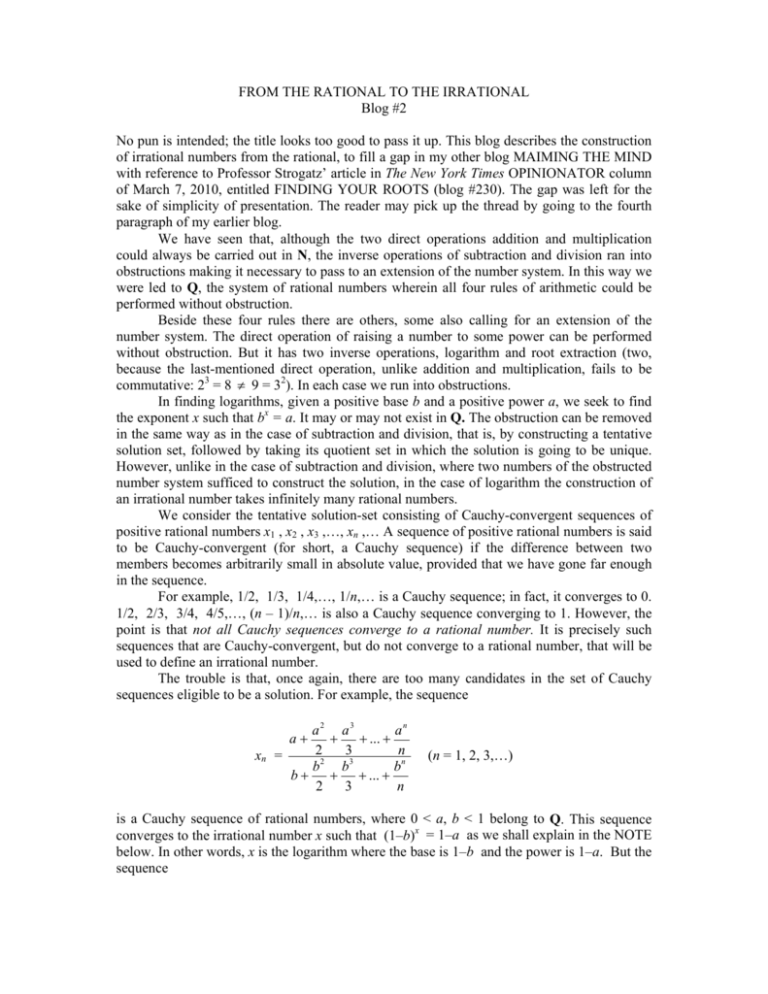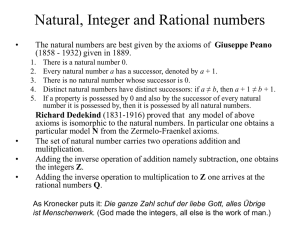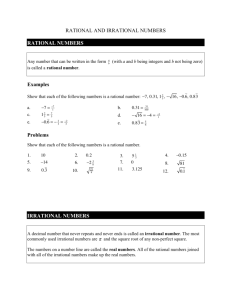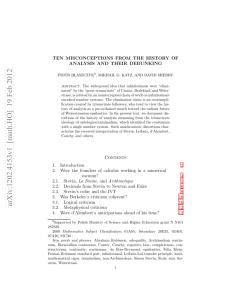FROM THE RATIONAL TO THE IRRATIONAL Blog #2 No pun is
advertisement

FROM THE RATIONAL TO THE IRRATIONAL Blog #2 No pun is intended; the title looks too good to pass it up. This blog describes the construction of irrational numbers from the rational, to fill a gap in my other blog MAIMING THE MIND with reference to Professor Strogatz’ article in The New York Times OPINIONATOR column of March 7, 2010, entitled FINDING YOUR ROOTS (blog #230). The gap was left for the sake of simplicity of presentation. The reader may pick up the thread by going to the fourth paragraph of my earlier blog. We have seen that, although the two direct operations addition and multiplication could always be carried out in N, the inverse operations of subtraction and division ran into obstructions making it necessary to pass to an extension of the number system. In this way we were led to Q, the system of rational numbers wherein all four rules of arithmetic could be performed without obstruction. Beside these four rules there are others, some also calling for an extension of the number system. The direct operation of raising a number to some power can be performed without obstruction. But it has two inverse operations, logarithm and root extraction (two, because the last-mentioned direct operation, unlike addition and multiplication, fails to be commutative: 23 = 8 ≠ 9 = 32). In each case we run into obstructions. In finding logarithms, given a positive base b and a positive power a, we seek to find the exponent x such that bx = a. It may or may not exist in Q. The obstruction can be removed in the same way as in the case of subtraction and division, that is, by constructing a tentative solution set, followed by taking its quotient set in which the solution is going to be unique. However, unlike in the case of subtraction and division, where two numbers of the obstructed number system sufficed to construct the solution, in the case of logarithm the construction of an irrational number takes infinitely many rational numbers. We consider the tentative solution-set consisting of Cauchy-convergent sequences of positive rational numbers x1 , x2 , x3 ,…, xn ,… A sequence of positive rational numbers is said to be Cauchy-convergent (for short, a Cauchy sequence) if the difference between two members becomes arbitrarily small in absolute value, provided that we have gone far enough in the sequence. For example, 1/2, 1/3, 1/4,…, 1/n,… is a Cauchy sequence; in fact, it converges to 0. 1/2, 2/3, 3/4, 4/5,…, (n – 1)/n,… is also a Cauchy sequence converging to 1. However, the point is that not all Cauchy sequences converge to a rational number. It is precisely such sequences that are Cauchy-convergent, but do not converge to a rational number, that will be used to define an irrational number. The trouble is that, once again, there are too many candidates in the set of Cauchy sequences eligible to be a solution. For example, the sequence a2 a3 an + + ... + n 2 3 xn = b 2 b3 bn b+ + + ... + n 2 3 a+ (n = 1, 2, 3,…) is a Cauchy sequence of rational numbers, where 0 < a, b < 1 belong to Q. This sequence converges to the irrational number x such that (1–b)x = 1–a as we shall explain in the NOTE below. In other words, x is the logarithm where the base is 1–b and the power is 1–a. But the sequence a2 a3 an + + ... + n + 1 2 3 xn' = 2 3 b b bn n b+ + + ... + n 2 3 a+ (n = 1, 2, 3,…) is also a Cauchy sequence and it converges to the same irrational number x. To ensure uniqueness we introduce an equivalence relation in calling two Cauchy sequences equivalent if their difference sequence converges to 0. The quotient set R of equivalence classes is the number system consisting of both rational and irrational numbers, collectively known as real numbers. Once again, we have extended the number system from Q to R through constructing a quotient set, the same method as was used to extend N to Z and Z to Q. Logarithms can be found in R without obstruction, and they are uniquely determined. Quotient sets provide a powerful and universal method to build the number concept. EXERCISES. (1) Find the limits of the Cauchy sequences (a) 1, 1.1, 1.11, 1.111,… (b) 1, 1.01, 1.0101, 1,010101,… (2) Find three different Cauchy sequences of rational numbers each converging to (3) Find a Cauchy sequence of rational numbers converging to π. (3) Find Cauchy sequences of rational numbers converging to e and 1/e. (5) Find a Cauchy sequence of rational numbers converging to log 2. 2. NOTE. To justify the statement that xn is a Cauchy sequence of rational numbers that converges to x where x is the solution of the exponential equation (1–b)x = 1–a where 1–a and 1–b are rational numbers between 0 and 1, we need a couple of facts from arithmetic and calculus concerning the function log x. log a ; We have: bx = a ⇒ x log b = log a ⇒ x = log b 1 y2 y3 yn = y+ + + ... + + ... where y < 1 . It follows that xn is a Cauchy sequence 1− y 2 3 n of rational numbers which converges to the irrational number x satisfying the exponential equation. log HINTS. (1) 1 1 1 1 10 = . + + + ... is a convergent geometric series with sum 1 9 10 100 1000 1− 10 1 1 1 1 100 + + + ... = = (b) 1 + . 1 100 10000 1000000 99 1− 100 (a) 1 + (2) (a) Use 2 = 1.4142… where the digits are obtained through the algorithm to calculate the square root of decimals. (b) To get a second Cauchy sequence, write: 1 1 = . 2+ x 2+ 1 2+ x Keep substitutig 1/(2+x) for x to get the so-called continued-fraction expansion 1 . 2 = 1+ 1 2+ 1 2+ 1 2+ 1 2+ 2 + ... ( x + 1)2 = 2 ⇒ x 2 + 2 x + 1 = 2 ⇒ x 2 + 2 x = 1 ⇒ x (2 + x ) = 1 ⇒ x = (c) To get a third, ⎛1 2 ⎞ ⎛1 2 ⎞ ⎛1 2 ⎞ use the binomial series (1 + x )1/ 2 = 1 + ⎜ ⎟ x + ⎜ ⎟ x 2 + ... + ⎜ ⎟ x n + ... ⎝ 1 ⎠ ⎝ 2 ⎠ ⎝ n ⎠ valid for |x| ≤ 1. 1 1 1 + − + −... obtained from the the power series 3 5 7 x3 x5 x 7 expansion: tg −1 x = x − + − + −... valid for |x| ≤ 1, by putting x = 1. 3 5 7 x x2 x3 (4) Use the power series expansion e x = 1 + + + + .... for x = 1, – 1. 1! 2! 3! (3) Use Leibniz’s series π/4 = 1 − 1 1 1 + − + −... obtained from the power series 2 3 4 x2 x3 x4 log(1 + x ) = x − + − + −... valid for – 1 < x < 1, 2 3 4 x = 1. (5) Use the series log 2 = 1 − expansion by putting (Revised March 22, 2010.)








